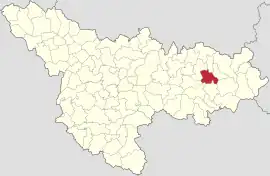Traian Vuia, Timiș
Traian Vuia (known as Bujor until 1950; Hungarian: Bozsor; German: Boschur) is a commune in Timiș County, Romania. It is composed of six villages: Jupani, Săceni, Sudriaș (commune seat), Surducu Mic, Susani and Traian Vuia.
Traian Vuia | |
|---|---|
 The Orthodox church in Traian Vuia | |
 Location in Timiș County | |
 Traian Vuia Location in Romania | |
| Coordinates: 45°48′N 22°4′E | |
| Country | Romania |
| County | Timiș |
| Government | |
| • Mayor (2020–2024) | Vasile Petruescu[1] (PSD) |
| Area | 69.75 km2 (26.93 sq mi) |
| Population (2021-12-01)[3] | 2,130 |
| • Density | 31/km2 (79/sq mi) |
| Time zone | EET/EEST (UTC+2/+3) |
| Postal code | 307435–307441 |
| Vehicle reg. | TM |
| Website | comunatraianvuia |
It was the birthplace of inventor and aviator Traian Vuia (1872–1950). It was renamed to commemorate him after his death. Traian Vuia is located near Lake Surduc.
Name
| Romanian | Hungarian | German |
|---|---|---|
| Jupani | Zsuppány | Schuppan |
| Săceni | Szécsény | Setschen |
| Sudriaș | Bégaszederjes | Sundriasch |
| Surducu Mic | Kisszurdok | Kleinsurduck |
| Susani | Bégaszuszány | Susan |
| Traian Vuia [Bujor] | Bozsor | Boschur |
History
The first recorded mention of Bujor dates from 1364.[4] The locality had a high importance in the Middle Ages, being the center of a Vlach district. In 1453 this district had a knyaz, Dionysius, and was donated by King Ladislaus V to John Hunyadi. In 1596 the Bujor District was part of Hunyad County. Within its borders there was at that time the village of Baia, and a little further the village of Chitești, both disappeared.
In the past, the hearth of the village was in the Gladna Valley, on the place called "Little Village" (Romanian: Satul mic). Due to the frequent floods, in 1823 the village was moved to its present place, protected from floods.[5]
Demographics
Traian Vuia had a population of 2,059 inhabitants at the 2011 census, down 8% from the 2002 census. Most inhabitants are Romanians (88.68%), larger minorities being represented by Roma (5.54%) and Ukrainians (1.94%). For 2.91% of the population, ethnicity is unknown.[6] By religion, most inhabitants are Orthodox (72.8%), but there are also minorities of Pentecostals (17.05%), Baptists (5.25%) and Roman Catholics (1.26%). For 2.91% of the population, religious affiliation is unknown.[7]
| Census[8] | Ethnic composition | |||||
|---|---|---|---|---|---|---|
| Year | Population | Romanians | Hungarians | Germans | Roma | Ukrainians |
| 1880 | 2,963 | 2,866 | 31 | 57 | – | – |
| 1890 | 3,197 | 3,078 | 54 | 41 | – | – |
| 1900 | 3,576 | 3,412 | 105 | 31 | – | – |
| 1910 | 4,134 | 3,574 | 438 | 34 | – | – |
| 1920 | 3,506 | 3,301 | 195 | 3 | – | – |
| 1930 | 3,697 | 3,308 | 282 | 36 | 55 | – |
| 1941 | 3,870 | 3,421 | 276 | 41 | – | – |
| 1956 | 3,350 | 3,079 | 172 | 4 | 93 | – |
| 1966 | 3,188 | 3,030 | 134 | 5 | 19 | – |
| 1977 | 3,005 | 2,819 | 91 | 1 | 87 | 6 |
| 1992 | 2,404 | 2,254 | 73 | 2 | 69 | 4 |
| 2002 | 2,241 | 2,015 | 52 | 5 | 118 | 51 |
| 2011 | 2,059 | 1,826 | 15 | – | 114 | 40 |
Gallery
 Orthodox church in Jupani
Orthodox church in Jupani.JPG.webp) Orthodox church in Traian Vuia
Orthodox church in Traian Vuia
References
- "Results of the 2020 local elections". Central Electoral Bureau. Retrieved 16 June 2021.
- "Strategia de dezvoltare a comunei Traian Vuia 2015 – 2020" (PDF). Primăria comunei Traian Vuia. p. 11.
- "Populaţia rezidentă după grupa de vârstă, pe județe și municipii, orașe, comune, la 1 decembrie 2021" (XLS). National Institute of Statistics.
- Pesty, Frigyes (1884). Krassó vármegye története (PDF). Vol. II. Budapest: Athenaeum R. Társ. Könyvnyomdája.
- "Istoric". Primăria comunei Traian Vuia.
- "Tab8. Populația stabilă după etnie – județe, municipii, orașe, comune". Institutul Național de Statistică.
- "Tab13. Populația stabilă după religie – județe, municipii, orașe, comune". Institutul Național de Statistică.
- Varga, E. Árpád. "Temes megye településeinek etnikai (anyanyelvi/nemzetiségi) adatai 1880-2002" (PDF).
